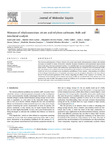Mixtures of Ethylammonium Nitrate and Ethylene Carbonate: Bulk and Interfacial Analysis

Use este enlace para citar
http://hdl.handle.net/2183/33982
Excepto si se señala otra cosa, la licencia del ítem se describe como Atribución-NoComercial-SinDerivadas 4.0 Internacional
Colecciones
- Investigación (FCIE) [1236]
Metadatos
Mostrar el registro completo del ítemTítulo
Mixtures of Ethylammonium Nitrate and Ethylene Carbonate: Bulk and Interfacial AnalysisAutor(es)
Fecha
2023-06-22Cita bibliográfica
Raúl Lois-Cuns, Martí¬n Otero-Lema, Alejandro Rivera-Pousa, Pablo Vallet, Juan J. Parajó, Óscar Cabeza, Hadrián Montes-Campos, Trinidad Méndez-Morales, Luis M. Varela,Mixtures of ethylammonium nitrate and ethylene carbonate: Bulk and interfacial analysis,Journal of Molecular Liquids,Volume 385,2023,122361,ISSN 0167-7322, https://doi.org/10.1016/j.molliq.2023.122361. (https://www.sciencedirect.com/science/article/pii/S0167732223011650)
Resumen
[Abstract] The structure and dynamics of binary mixtures of a protic ionic liquid (ethylammonium nitrate) and ethylene carbonate are studied by means of atomistic molecular dynamics simulations and experimental measurements both in bulk and at the electrochemical interface. The solubility limit was experimentally found at 0.6 carbonate molar fraction. Likewise, density and conductivity experimental data are compared with computational results. Also, distribution and correlation functions obtained from bulk simulations are analyzed in the miscible range to clarify the role of the carbonate in the coordination and diffusion of ionic species. Understanding the evolution of the hydrogen bond network is of particular importance since its strength is detected as the most relevant feature in the structural organization of the mixture. Regarding the effects of the presence of an interface, the orientations of the molecules and the density and charge profiles are calculated both in the absence and in the presence of an electric field. This analysis reveals the tendency of the carbonate to displace the ionic liquid from the near-wall region when concentration is increased.
Palabras clave
Ionic liquid
Ethylene carbonate
Electrochemical interface
Structure
Dynamics
Molecular dynamics simulations
Ethylene carbonate
Electrochemical interface
Structure
Dynamics
Molecular dynamics simulations
Versión del editor
Derechos
Atribución-NoComercial-SinDerivadas 4.0 Internacional
ISSN
0167-7322






